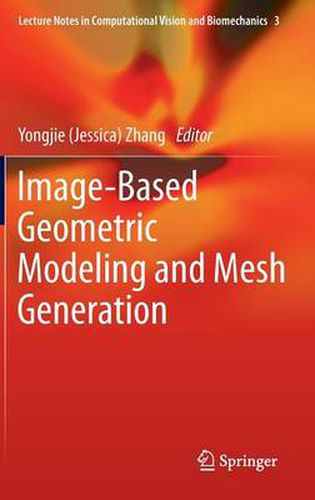Readings Newsletter
Become a Readings Member to make your shopping experience even easier.
Sign in or sign up for free!
You’re not far away from qualifying for FREE standard shipping within Australia
You’ve qualified for FREE standard shipping within Australia
The cart is loading…






This title is printed to order. This book may have been self-published. If so, we cannot guarantee the quality of the content. In the main most books will have gone through the editing process however some may not. We therefore suggest that you be aware of this before ordering this book. If in doubt check either the author or publisher’s details as we are unable to accept any returns unless they are faulty. Please contact us if you have any questions.
As a new interdisciplinary research area, image-based geometric modeling and mesh generation integrates image processing, geometric modeling and mesh generation with finite element method (FEM) to solve problems in computational biomedicine, materials sciences and engineering. It is well known that FEM is currently well-developed and efficient, but mesh generation for complex geometries (e.g., the human body) still takes about 80% of the total analysis time and is the major obstacle to reduce the total computation time. It is mainly because none of the traditional approaches is sufficient to effectively construct finite element meshes for arbitrarily complicated domains, and generally a great deal of manual interaction is involved in mesh generation.
This contributed volume, the first for such an interdisciplinary topic, collects the latest research by experts in this area. These papers cover a broad range of topics, including medical imaging, image alignment and segmentation, image-to-mesh conversion, quality improvement, mesh warping, heterogeneous materials, biomodelcular modeling and simulation, as well as medical and engineering applications.
This contributed volume, the first for such an interdisciplinary topic, collects the latest research by experts in this area. These papers cover a broad range of topics, including medical imaging, image alignment and segmentation, image-to-mesh conversion, quality improvement, mesh warping, heterogeneous materials, biomodelcular modeling and simulation, as well as medical and engineering applications.
This contributed volume, the first for such an interdisciplinary topic, collects the latest research by experts in this area. These papers cover a broad range of topics, including medical imaging, image alignment and segmentation, image-to-mesh conversion, quality improvement, mesh warping, heterogeneous materials, biomodelcular modeling and simulation, as well as medical and engineering applications.
This contributed volume, the first for such an interdisciplinary topic, collects the latest research by experts in this area. These papers cover a broad range of topics, including medical imaging, image alignment and segmentation, image-to-mesh conversion, quality improvement, mesh warping, heterogeneous materials, biomodelcular modeling and simulation, as well as medical and engineering applications.
$9.00 standard shipping within Australia
FREE standard shipping within Australia for orders over $100.00
Express & International shipping calculated at checkout
This title is printed to order. This book may have been self-published. If so, we cannot guarantee the quality of the content. In the main most books will have gone through the editing process however some may not. We therefore suggest that you be aware of this before ordering this book. If in doubt check either the author or publisher’s details as we are unable to accept any returns unless they are faulty. Please contact us if you have any questions.
As a new interdisciplinary research area, image-based geometric modeling and mesh generation integrates image processing, geometric modeling and mesh generation with finite element method (FEM) to solve problems in computational biomedicine, materials sciences and engineering. It is well known that FEM is currently well-developed and efficient, but mesh generation for complex geometries (e.g., the human body) still takes about 80% of the total analysis time and is the major obstacle to reduce the total computation time. It is mainly because none of the traditional approaches is sufficient to effectively construct finite element meshes for arbitrarily complicated domains, and generally a great deal of manual interaction is involved in mesh generation.
This contributed volume, the first for such an interdisciplinary topic, collects the latest research by experts in this area. These papers cover a broad range of topics, including medical imaging, image alignment and segmentation, image-to-mesh conversion, quality improvement, mesh warping, heterogeneous materials, biomodelcular modeling and simulation, as well as medical and engineering applications.
This contributed volume, the first for such an interdisciplinary topic, collects the latest research by experts in this area. These papers cover a broad range of topics, including medical imaging, image alignment and segmentation, image-to-mesh conversion, quality improvement, mesh warping, heterogeneous materials, biomodelcular modeling and simulation, as well as medical and engineering applications.
This contributed volume, the first for such an interdisciplinary topic, collects the latest research by experts in this area. These papers cover a broad range of topics, including medical imaging, image alignment and segmentation, image-to-mesh conversion, quality improvement, mesh warping, heterogeneous materials, biomodelcular modeling and simulation, as well as medical and engineering applications.
This contributed volume, the first for such an interdisciplinary topic, collects the latest research by experts in this area. These papers cover a broad range of topics, including medical imaging, image alignment and segmentation, image-to-mesh conversion, quality improvement, mesh warping, heterogeneous materials, biomodelcular modeling and simulation, as well as medical and engineering applications.